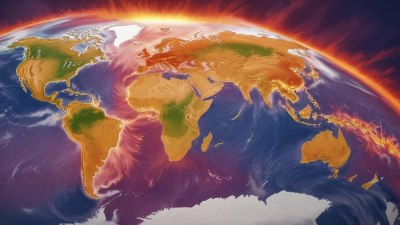What Causes Record-Breaking Temperatures
Explore the factors contributing to record-breaking temperatures and their impact on the environment.

This image was created with the assistance of Freepik
In recent years, we have witnessed numerous instances of record-breaking temperatures across the globe. These extreme heat events are not just mere fluctuations in weather; they are indicative of broader climatic shifts caused by a myriad of factors. Understanding the causes of these rising temperatures is crucial in addressing the implications they hold for our planet. This article delves into the primary contributors to record-breaking temperatures, examining both natural occurrences and human-induced activities.
Greenhouse Gas Emissions
One of the most significant contributors to rising temperatures is the increase in greenhouse gas emissions, primarily carbon dioxide (CO2), methane (CH4), and nitrous oxide (N2O). These gases trap heat in the Earth’s atmosphere, creating what is known as the greenhouse effect. The burning of fossil fuels for energy, deforestation, and agricultural practices have led to unprecedented levels of these gases in the atmosphere. As concentrations of greenhouse gases rise, so does the global average temperature. The Intergovernmental Panel on Climate Change (IPCC) reports that human activities have caused approximately 1.1 degrees Celsius of warming since the late 19th century, with considerable variation in regional temperatures.
Urban Heat Islands
Urbanization plays a crucial role in exacerbating temperature extremes through the formation of urban heat islands (UHIs). Cities, with their dense concentrations of buildings, asphalt, and other materials, absorb and retain heat more than rural areas. During summer months, UHIs can result in temperatures in urban centers that are several degrees higher than surrounding rural areas. The phenomenon is compounded by the lack of vegetation in urban areas, which otherwise provides shade and cools the environment through evapotranspiration. As more people migrate to cities, the heat-absorbing surfaces increase, worsening the UHI effect and leading to higher temperatures during heat waves.
Climate Change and Weather Patterns
Climate change significantly alters weather patterns, leading to increased heat extremes. Warmer average temperatures can intensify heat waves, making them more frequent and severe. Changes in patterns of precipitation can also contribute to these extremes. For instance, regions suffering from drought may experience even hotter conditions due to the lack of moisture in the ground and air. Furthermore, shifts in atmospheric circulation patterns can lead to prolonged periods of heat in certain regions, affecting local climates. Weather systems that usually bring cooler temperatures or precipitation may become less frequent or intense, allowing heat to build up.
El Niño and La Niña Phenomena
The El Niño Southern Oscillation (ENSO) is a climate pattern that impacts global weather and can cause significant fluctuations in temperature. El Niño, characterized by warmer Pacific Ocean temperatures, typically brings warmer and drier conditions to many regions, contributing to higher temperatures. Conversely, La Niña, which involves cooler ocean temperatures, can have the opposite effect, leading to cooler conditions in some areas. However, the complexity of these phenomena means that their impact on heat extremes can vary regionally. During strong El Niño years, record-breaking temperatures can result globally, compounding the effects of climate change.
Deforestation and Land Use Changes
Deforestation and land use changes are critical contributors to rising temperatures as well. Trees and vegetation play a significant role in regulating local and global climates. They absorb CO2 from the atmosphere, helping to mitigate the greenhouse effect. When forests are cleared for agriculture, urban development, or other purposes, not only is CO2 released into the atmosphere, but the land's ability to cool through natural processes is diminished. Furthermore, land use changes can impact local weather patterns, often leading to increased temperatures in deforested areas.
Feedback Loops
Climate change is further complicated by feedback loops that can exacerbate warming. For example, as polar ice melts due to rising temperatures, less sunlight is reflected back into space (the albedo effect), causing further warming and ice melt. Similarly, thawing permafrost releases stored greenhouse gases, further contributing to the greenhouse effect. These feedback mechanisms can result in a rapid escalation of temperature increases, making it more challenging to predict and mitigate climate impacts.
Agricultural Practices
Agricultural practices play a significant role in temperature fluctuations. Intensive farming methods often contribute to greenhouse gas emissions through the use of synthetic fertilizers and livestock management. Moreover, irrigation, while crucial for crop production, can alter local climates and increase temperatures in specific regions. Changes in land cover due to agricultural expansion can mitigate some of the cooling effects trees provide, exemplifying further human impact on temperature extremes.
Impact of Climate Change on Extreme Weather
As temperatures soar, the relationship between climate change and extreme weather events becomes increasingly apparent. Record-breaking temperatures are often accompanied by severe weather phenomena such as heatwaves, droughts, and even storms. It's essential to recognize how these events interconnect; for instance, extreme heat can exacerbate drought conditions, leading to increased wildfire risk in many regions. Consequently, it further reinforces the cycle of climate change, affecting ecosystems, wildlife, and human livelihoods.
In conclusion, understanding what causes record-breaking temperatures is vital for developing effective strategies to combat climate change. A multitude of interlinked factors, including greenhouse gas emissions, urbanization, climate variability, land use changes, and agricultural practices, contribute to rising temperatures globally. As we navigate a warming world, it becomes increasingly important to address these issues collectively, emphasizing sustainable practices and policies. By understanding the root causes, we can work towards minimizing their impact and fostering a more resilient future for our planet.











